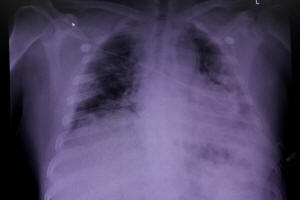Lung damage found in COVID dead may shed light on 'long COVID': study
 Send a link to a friend
Send a link to a friend
 [November 04, 2020]
By Kate Kelland [November 04, 2020]
By Kate Kelland
LONDON (Reuters) - A study of the lungs of
people who have died from COVID-19 has found persistent and extensive
lung damage in most cases and may help doctors understand what is behind
a syndrome known as 'long COVID', in which patients suffer ongoing
symptoms for months.
Scientists leading the research said they also found some unique
characteristics of SARS-CoV-2, the virus that causes COVID-19, which may
explain why it is able to inflict such harm.
"The findings indicate that COVID-19 is not simply a disease caused by
the death of virus-infected cells, but is likely the consequence of
these abnormal cells persisting for long periods inside the lungs," said
Mauro Giacca, a professor at King’s College London who co-led the work.

The research team analysed samples of tissue from the lungs, heart,
liver and kidneys of 41 patients who died of COVID-19 at Italy's
University Hospital of Trieste between February and April 2020.
In a telephone interview, Giacca said that, while his research team
found no overt signs of viral infection or prolonged inflammation in
other organs, they discovered "really vast destruction of the
architecture of the lungs", with healthy tissue "almost completely
substituted by scar tissue".
"MASSIVE" DAMAGE
"It could very well be envisaged that one of the reasons why there are
cases of long COVID is because there is vast destruction of lung
(tissue)," he told Reuters. "Even if someone recovers from COVID, the
damage that is done could be massive."
[to top of second column]
|

An X-ray of a COVID-19 patient's lungs at United Memorial Medical
Center in Houston, Texas, U.S., July 10, 2020. REUTERS/Callaghan
O'Hare

Growing evidence from around the world suggests that a small
proportion of people who have had COVID-19 and recovered from their
initial infection can experience a range of ongoing symptoms
including fatigue, brain fog and shortness of breath. The condition
is often called "long COVID".
Giacca said almost 90% of the 41 patients had several
characteristics unique to COVID-19 compared to other forms of
pneumonia.
One was that patients had extensive blood clotting of the lung
arteries and veins. Another was that some lung cells were abnormally
large and had many nuclei - a result of the fusion of different
cells into single large cells in a process known as syncytia.
The research, published in the journal Lancet eBioMedicine, also
found the virus itself was still present in many types of cells.
"The presence of these infected cells can cause the major structural
changes observed in lungs, which can persist for several weeks or
months and could eventually explain 'long COVID'," Giacca said.

(Reporting by Kate Kelland, editing by Gareth Jones)
[© 2020 Thomson Reuters. All rights
reserved.] Copyright 2020 Reuters. All rights reserved. This material may not be published,
broadcast, rewritten or redistributed.
Thompson Reuters is solely responsible for this content. |